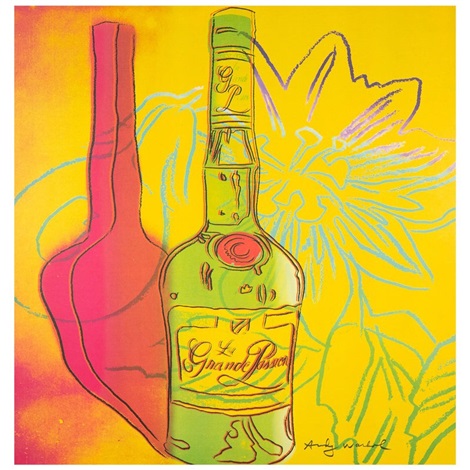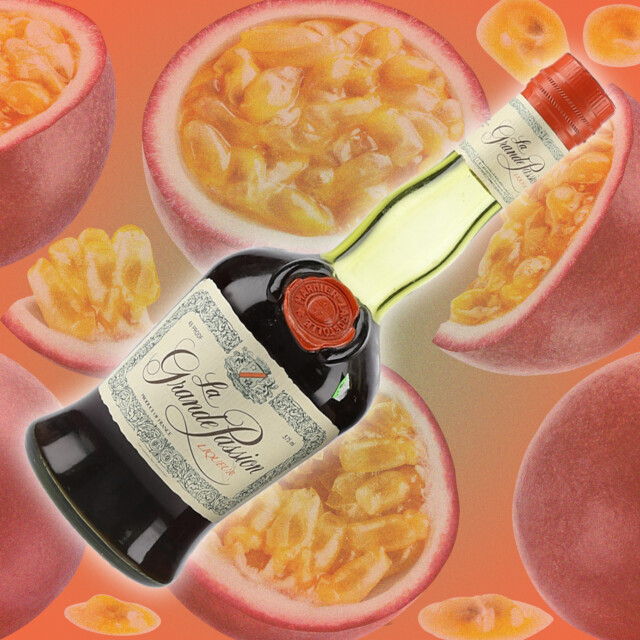This spring, noted bartender Jeffrey Morgenthaler began auctioning off some of the rarer and more valuable liquor bottles he’d acquired from nearly three decades in the bar business. There were the bourbon unicorns you’d expect — a William Larue Weller and unique single barrels he personally selected while running Clyde Common — as well as vintage “holy grail” tequilas like pre-diffuser Herradura, and plenty of dusty bottles like a 1970s Campari.
But the one bottle that piqued my interest wasn’t a trophy bourbon or decades-old tequila. It was a liqueur I’d never seen before: La Grande Passion.
“Boy do I wish Grand Marnier still [made] this passion fruit liqueur,” Morgenthaler wrote in the auction post. “Talk about the best vintage Pornstar Martini ever made.”
For about a decade, from 1984 to 1994, Marnier-Lapostolle offered a unique passion fruit twist on its iconic Grand Marnier Cordon Rouge, an orange liqueur made from a blend of Cognac, distilled orange essence, and sugar.
It vanished from shelves 30 years ago. It had no signature cocktail. And yet, to a small but devoted cult, La Grande Passion may just have been one of the best liqueurs ever made.
The Oddity
“La Grande Passion is one of those oddities that was much better than the market it was (briefly) launched into,” says Eric Witz, a vintage spirits collector and expert.
Instead of a Cognac base like its signature product, Marnier-Lapostolle opted for Armagnac and, yes, passion fruit instead of orange essence. It was sweeter and lower-proof than Cordon Rouge, too, at a mere 24 percent ABV compared to the former’s 40 percent — befitting a more health-conscious era. Aside from the Marnier-Lapostolle name stamped on a wax seal in the middle of the bottle’s neck, there was no other reference to Grand Marnier on the packaging.
So who exactly was this product for?
DeKuyper Original Peachtree Schnapps had been released earlier in the summer of 1984, and became an immediate sensation, reportedly the fastest-selling new alcohol product since Prohibition. La Grande Passion was far pricier than Peachtree, selling for $17 to $22 a bottle compared to about $5 for the DeKuyper liqueur.
And while the 1980s was an era of fruity cocktails — think the Fuzzy Navel and Sex on the Beach — there wasn’t an iconic passion fruit liqueur cocktail until the Pornstar Martini arrived in 2002.
“It’s around the same time that newspaper articles start talking about this strange wrinkled fruit you might find in the grocery story, so it probably has something to do with it being the flavor of the moment.”
Not even drinkers of the era knew what to do with this elegant but pricey product. Upon its release, The Idaho Statesman even suggested cutting up an assortment of tropical fruits and using La Grande Passion as a salad dressing.
That was, sadly, one of the few pieces of press the ahead-of-its-time liqueur ever received.
Heart-Shaped Box
Since its creation in 1880, Grand Marnier had tried other flavored line extensions, like Cherry Marnier, which existed in various forms and names until 1999 in the U.S. market and much later in Europe. There were also Vanilla Cherry and Raspberry Peach “Signature Collection” releases in 2012 and 2013. None are remembered as fondly or have the cult following of La Grande Passion.
Morgenthaler wasn’t bartending during La Grande Passion’s brief life. “I only started tending bar in 1996, and in the sorts of places that wouldn’t have carried a product like this anyway,” he told me. He bought his first bottles about a decade ago after finding a stash in a California liquor store. He quickly fell for the product and now regrets being down to only half of one bottle.

So do many others online who’ve stumbled upon bottles, with most agreeing it’s amazing.
Tammy Coxen of My Tiny Bottles is also a fan, and has featured the bottle on her web series. She has two theories for why La Grande Passion hit the scene when it did.
“It’s around the same time that newspaper articles start talking about this strange wrinkled fruit you might find in the grocery story, so it probably has something to do with it being the flavor of the moment,” she proposes. That’s confirmed by a Wall Street Journal article from 1984 talking of a “passion fruit craze…headed for the U.S. mainland.”
Witz adds that Alizé — a blend of vodka, Cognac, and passion fruit produced by the Kobrand Corporation — was likewise introduced in 1984.
“Maybe Marnier identified a potentially more ‘upscale’ market niche than Alizé was aiming for,” he says.
Coxen’s other theory is that La Grande Passion was created as a romantic holiday release, with the ad slogan “In life there are many loves, but only one Grande Passion.” The 750-milliliter bottles came in a holiday gift tin, while a Valentine’s Day offering presented a 375-milliliter bottle in a heart-shaped box. The latter seems to have done well enough that Coxen believes it inspired the almond-flavored Cognac liqueur Le Grand Amour.
Its mystique also attracted artists, like Clayton Lefevre, who produced a modernist-style lithograph of the bottle (and two lovers?) in 1989, and Andy Warhol, who produced an intriguing illustrated lithograph as well.
“La Grande Passion was one of the more common old bottles to encounter in the wild for a long time.”
“All I can say for sure is that [La Grande Passion] itself is delicious,” says Witz. “A really lovely bright fruit overlaid upon a rich, oaky, Armagnac base. A flavor profile more assertive than the traditional Grand Marnier but made with the same careful attention to detail.”
Unfortunately, it may have been too well made for its era. The Armagnac base was a heckuva lot more expensive than the grain neutral spirit used in Peachtree or the vodka used in Alizé and other fruity liqueurs of the era.
By 1994, La Grande Passion was off the market. That was, perhaps not coincidentally, the same year the company now known as Southern Glazer’s took over Grand Marnier’s U.S. distribution.
Stoking the Passion
Like Morgenthaler, Witz once stumbled across plenty of vintage bottles while dusty-hunting at liquor stores. But not anymore.
“La Grande Passion was one of the more common old bottles to encounter in the wild for a long time,” he says, noting he mostly found examples produced between 1985 and 1989. “But nowadays most of those old bottles have been scooped up so you will most likely only find it at auction.”
Prices vary wildly these days, but even at auction, Witz thinks it remains sorely undervalued. Yes, some bottles sell online for $600, but then there’s Morgenthaler’s bottle, which sold for a mere $35 just last month, despite his glowing endorsement. Other fans try to recreate La Grande Passion at home with fresh fruit.
Ahead of its time, still misunderstood, hard to use, and mostly forgotten — none of that matters to Witz, who says:
“It’s a really tasty liqueur that I think is not as appreciated as it should be.”
